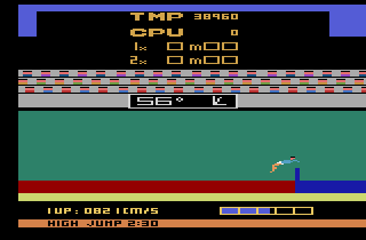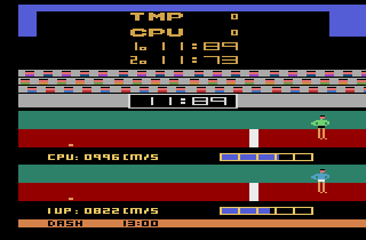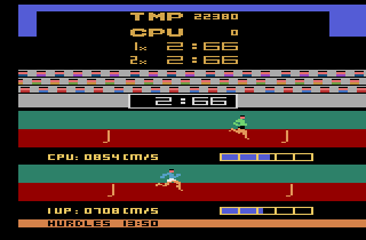|
|
Track and Field
|
Name:
|
Track and Field |
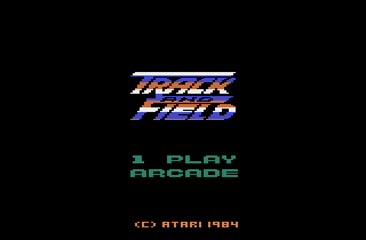 |
| Company: | Atari | |
|
Model #:
|
CX-26125 | |
|
Programmers:
|
Seth Lipkin, Jaques Hugon, and Allen Wells
(GCC) |
|
| Year: | 1984 | |
|
Released?
|
Yes
|
|
|
Notes:
|
Port of the 1983 Konami/Centuri coin-op |
In 1983 Centuri developed what would become the model for track games for years to come. Track and Field (also known as Hyper Olympics outside the US) is quite possibly one of the most addictive multiplayer sports games ever created. It seemed only natural that with the 1984 Olympics in town that Atari would want to cash in with their sponsorship, so while the Atari 800XL became the official computer of the 1984 Los Angeles Olympics (I wasnít aware there was an official Olympic computer), Track and Field became the official game. Originally Track and Field was going to simply be called the Los Angeles 1984 Games, but was changed back to Track and Field before being released. Prototypes with the original title still exist, and if the Atari 8-bit version is played on a PAL machine it still displays this title (it is unknown if the 5200 prototype displays the same behavior as there are no PAL 5200ís to test it on).
The beauty of Track and Field lies in its simple controls and easy to learn rules. Originally the game came with its own special controller (a three button pad with two run buttons and a jump button), but this controller only served to mimic the arcade controls and was not required by the game itself. If the player did not have the special controller, they could simply push the joystick left and right to simulate the running buttons. Activision's Decathlon used a similar setup, and not-so coincidentally can be played with the Track and Field controller.
Track and Field consists of six events. These events are really a set of six separate mini-games which each player must master. The key to winning most events is knowing when to hit the jump/throw button and the most optimal angel to jump or throw at. Careful timing will make the difference between sweet victory and bitter defeat. Each event has a qualifying score which the player must meet or pass to advance to the next event or they loose a life (I guess it really is do or die!). Every time a player cycles through all six events the qualifying scores increase until they require super human reflexes to beat.
Event #1: 100m Dash
The 100m Dash is the easiest of the six events to master. Simply push left and right as fast as you can until your man crosses the finish line. If the player moves before the starter gun is fired it counts as a false start (two false starts and the player fails the event). Since there's no jump button involved, this event is one of the easiest to qualify for even at the higher levels.
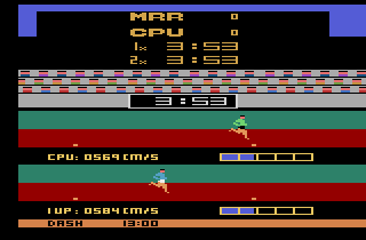
Event #2: Long Jump
The Long Jump is player in much the same way as the 100m Dash, except the player must push the jump button before they reach the white line at the end of the track. If the player crosses the white line it is considered to be a fault and they loose one of their three attempts. The amount of time the player holds down the jump button at the end of the track determines the angle of the jump. The angle starts out at 0 degrees and increases the longer the button is held down. The optimal jump angle is 45 degrees. Be careful in timing your jump your player will keep moving as you're choosing your angle (unlike in the arcade where your player would stop while the angle was being displayed). To jump at a small angle make sure you start holding the button down well in advance of the white line.
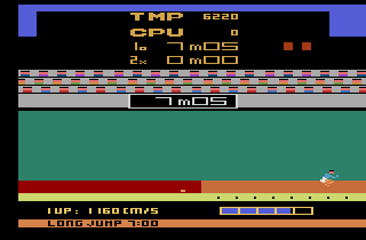
Event #3: Javelin
Similar to the Long Jump except instead of jumping at the end of the track, the player throws a javelin instead. As with the Long Jump, the longer the player holds down the throw button the steeper the angle of the throw. This event is one of the easiest to qualify for due to the super human throwing ability of your character. Watch out, because you will move while the angle is being calculated in this event as well. The optimal throwing angle is 42 degrees.
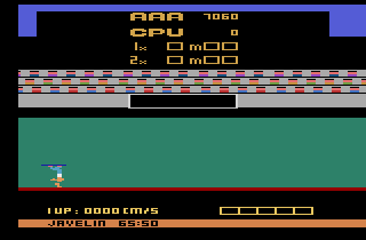
Event #4: 110m Hurdles
The 110m Hurdles are exactly the same as the 100m Dash except the player must constantly push the jump button to clear the incoming hurdles. Hitting a hurdle will slow your character down and cost the player some time at the end of the event.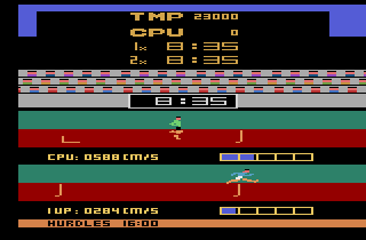
Event #5: Hammer Throw
The Hammer Throw is completely different from the other five events. This event is all about timing rather than rapid button mashing. Once the event starts the hammer thrower will begin to slowly flash red. Each rotation is marked by the hammer thrower flashing red and making a sound, the speed of the flashes get faster and faster the longer you wait until eventually you foul out.
The secret to winning this event is to release the hammer when the thrower has maximum speed but before you foul. The tricky part is making sure the hammer will fly straight ahead instead of to the side. If the hammer veers off course it will hit the sides of the cage and be counted as a fault. Complicating matters is the fact that the thrower is moving with great speed so timing the release of the hammer is more a matter of luck than skill. This is one of the hardest events in which to qualify.
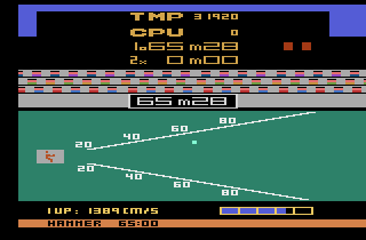
Event #6: High Jump
The High Jump is the sixth and final event. This event is played like the Long Jump except instead of going for distance, players are trying to go for height (about 65 degrees is considered optimal). Unlike the other events, the angle counter starts at 90 degrees (straight up) and decreases the longer the player holds down the jump button. The High Jump is a special event as the player must complete the High Jump several times until the qualifying height has been reached (extra points are awarded for going over). For some odd reason your character automatically runs for you in this event so there is no need to push left and right. This event is rather difficult to complete, but practice is the key.
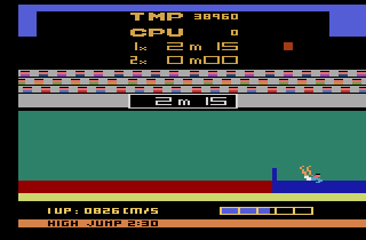
Track and field is simply amazing on the 2600. Itís hard to believe that they could squeeze the entire arcade game into a tiny 2600 cartridge, but they managed it somehow. Unfortunately Track and Field was released right as Atari was experiencing major financial difficulties and was only released in very small quantities (the Atari 8-bit version suffered a similar fate). The label is also something of a mystery as it is in black & white instead of color (except for the title which is in pink!) and has the wrong part number on it (the label says CX26127 which is actually Gremlins part number, it should say CX26125). It is unknown why the label looks this way, but it could be due to the cost cutting measures that were in place at the time. The box is particularly difficult to come by as it was oversized to fit the special controller and easily damaged.
| Version | Cart Text | Description |
| ?/??/84 | N/A | Title screen says 1984 Los Angeles Games |

